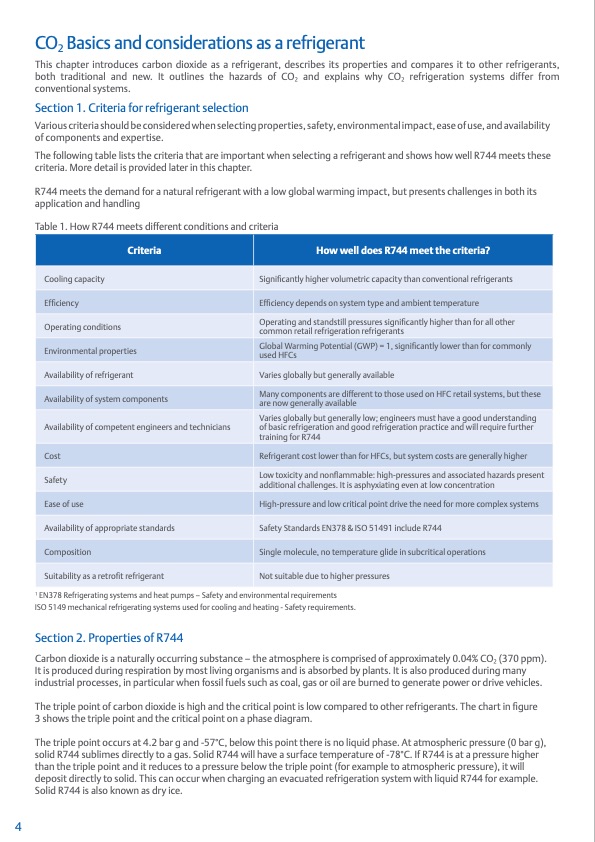
PDF Publication Title:
Text from PDF Page: 004
CO2 Basics and considerations as a refrigerant This chapter introduces carbon dioxide as a refrigerant, describes its properties and compares it to other refrigerants, both traditional and new. It outlines the hazards of CO2 and explains why CO2 refrigeration systems differ from conventional systems. Section 1. Criteria for refrigerant selection Various criteria should be considered when selecting properties, safety, environmental impact, ease of use, and availability of components and expertise. The following table lists the criteria that are important when selecting a refrigerant and shows how well R744 meets these criteria. More detail is provided later in this chapter. R744 meets the demand for a natural refrigerant with a low global warming impact, but presents challenges in both its application and handling Table 1. How R744 meets different conditions and criteria Criteria How well does R744 meet the criteria? Cooling capacity Significantly higher volumetric capacity than conventional refrigerants Efficiency Efficiency depends on system type and ambient temperature Operating conditions Operating and standstill pressures significantly higher than for all other common retail refrigeration refrigerants Environmental properties Global Warming Potential (GWP) = 1, significantly lower than for commonly used HFCs Availability of refrigerant Varies globally but generally available Availability of system components Many components are different to those used on HFC retail systems, but these are now generally available Availability of competent engineers and technicians Varies globally but generally low; engineers must have a good understanding of basic refrigeration and good refrigeration practice and will require further training for R744 Cost Refrigerant cost lower than for HFCs, but system costs are generally higher Safety Low toxicity and nonflammable: high-pressures and associated hazards present additional challenges. It is asphyxiating even at low concentration Ease of use High-pressure and low critical point drive the need for more complex systems Availability of appropriate standards Safety Standards EN378 & ISO 51491 include R744 Composition Single molecule, no temperature glide in subcritical operations Suitability as a retrofit refrigerant Not suitable due to higher pressures 4 1 EN378 Refrigerating systems and heat pumps – Safety and environmental requirements ISO 5149 mechanical refrigerating systems used for cooling and heating - Safety requirements. Section 2. Properties of R744 Carbon dioxide is a naturally occurring substance – the atmosphere is comprised of approximately 0.04% CO2 (370 ppm). It is produced during respiration by most living organisms and is absorbed by plants. It is also produced during many industrial processes, in particular when fossil fuels such as coal, gas or oil are burned to generate power or drive vehicles. The triple point of carbon dioxide is high and the critical point is low compared to other refrigerants. The chart in figure 3 shows the triple point and the critical point on a phase diagram. The triple point occurs at 4.2 bar g and -57°C, below this point there is no liquid phase. At atmospheric pressure (0 bar g), solid R744 sublimes directly to a gas. Solid R744 will have a surface temperature of -78°C. If R744 is at a pressure higher than the triple point and it reduces to a pressure below the triple point (for example to atmospheric pressure), it will deposit directly to solid. This can occur when charging an evacuated refrigeration system with liquid R744 for example. Solid R744 is also known as dry ice.PDF Image | CO2 Product Guide 2021

PDF Search Title:
CO2 Product Guide 2021Original File Name Searched:
2021-co2-refrigeration-4217772.pdfDIY PDF Search: Google It | Yahoo | Bing
CO2 Organic Rankine Cycle Experimenter Platform The supercritical CO2 phase change system is both a heat pump and organic rankine cycle which can be used for those purposes and as a supercritical extractor for advanced subcritical and supercritical extraction technology. Uses include producing nanoparticles, precious metal CO2 extraction, lithium battery recycling, and other applications... More Info
Heat Pumps CO2 ORC Heat Pump System Platform More Info
| CONTACT TEL: 608-238-6001 Email: greg@infinityturbine.com | RSS | AMP |